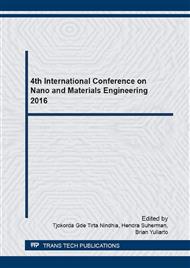p.65
p.70
p.77
p.81
p.86
p.91
p.99
p.106
p.112
Porcine-Bone Derived Hydroxyapatite Coating on Anodized Titanium Substrate
Abstract:
Titanium-based alloys are among the most common materials implanted into the human body to permanently support or replace injured or disease-damaged bones due to their high flexural strength and tolerable elastic modulus. However, titanium is considered a bio-inert material and surface modification is needed to improve its bioactivity. Studies have shown that hydroxyapatite coatings are typically bioactive but have poor adhesion strength to titanium. On the other hand, TiO2 coatings strongly adhere to titanium but their bioactivity is limited. This study aims to improve the surface properties of titanium by anodic oxidation and coated with porcine bone-derived hydroxyapatite (HAp). The influence of different anodization voltage on the surface morphology of the titanium substrate and the coating was investigated. The average roughness and wetting angle of the HAp/TiO2 coating increased along with the increasing applied voltage. The increase in roughness and wetting angle is attributed to the change in pore size of TiO2 layer when subjected to varying voltage. With the influence of surface roughness and morphology on the biological performance of titanium implants, the correlation of improved roughness in the coating to the bioactivity can be considered.
Info:
Periodical:
Pages:
86-90
Citation:
Online since:
August 2016
Keywords:
Price:
Сopyright:
© 2016 Trans Tech Publications Ltd. All Rights Reserved
Share:
Citation:


